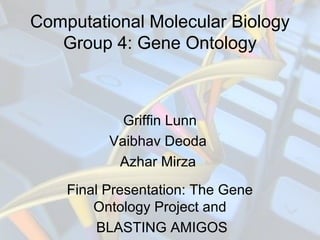The document discusses two programs - BLASTing AmiGOs and "33" - that were designed to automatically generate Gene Ontology (GO) terms from gene/protein sequences. BLASTing AmiGOs takes FASTA sequences as input and outputs the associated GO terms without manual input. "33" queries a GO database using gene products from another group to retrieve GO terms and evidence codes. Manually collecting the same GO term data for 32 genes took 4-5 hours, while the programs could generate the terms automatically. The document compares the manual and automated methods and discusses using computational tools to help biologists more efficiently organize and access expanding genomic data.





















![Types of Relationships
• Is_a [i]
• Part_of [p]
• Regulates/ positively_regulates / negatively_regulates [r]
GO:0010467 : gene expression
[r] GO:0010468 : regulation of gene expression
---[i] GO:0045449 : regulation of transcription
[p] GO:0006350 : transcription
---[r] GO:0045449 : regulation of transcription](https://image.slidesharecdn.com/geneontologyproject-124111775769-phpapp01/85/Gene-Ontology-Project-22-320.jpg)
![Is_a Relationships
• Simple parent-child relationship
• A is_a B means A is a subclass of B
GO:0043232 : intracellular non-membrane-bound organelle
[i] GO:0005694 : chromosome
---[i] GO:0000228 : nuclear chromosome](https://image.slidesharecdn.com/geneontologyproject-124111775769-phpapp01/85/Gene-Ontology-Project-23-320.jpg)
![Part_of Relationships
• C part_of D means that whenever C is
present, it is always a part of D, but C
does not always have to be present.
[i] GO:0042597 : periplasmic space
---[p] GO:0055040 : periplasmic flagellum
“When a periplasmic flagellum is present, it is always part_of
a periplasmic space. However, every periplasmic space does
not necessarily have a periplasmic flagellum.”](https://image.slidesharecdn.com/geneontologyproject-124111775769-phpapp01/85/Gene-Ontology-Project-24-320.jpg)











































